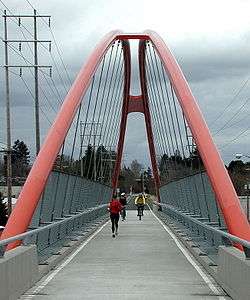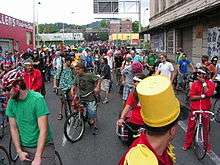Cycling in Portland, Oregon
Bicycle use in Portland, Oregon has been growing rapidly, having nearly tripled since 2001; for example, bicycle traffic on four of the Willamette River bridges has increased from 2,855 before 1992 to over 16,000 in 2008, partly due to improved facilities.[1] The Portland Bureau of Transportation says 6% of commuters bike to work in Portland, the highest proportion of any major U.S. city and about 10 times the national average.[2]
Due to its urban bicycling efforts, Portland has earned multiple "bicycle-friendly city" awards,[3][4][5] including being awarded platinum status by the League of American Bicyclists,[6][7] and it ranks highly among the most bicycle friendly cities in the world.[8][9]
By July 2016 through a 4-0 city council vote, Portland will have a bike share program running with 600 bikes. The new bikes will be provided by Social Bicycles, and will be operated by Motivate.[10]
History
The Yellow Bike Project
Portland's reputation as a bike-friendly City was enhanced by The Yellow Bike Project, a 1994 civic engagement action and the brainchild of Portland, Oregon activist Tom O'Keefe. After watching the documentary "Sex Drugs & Democracy", O'Keefe proposed painting donated bikes – repaired by at-risk-youth served by the Portland based Community Cycling Center – bright yellow, and deploying them for free use around Portland. "Gratis Pedalis Feralvus" was a tongue-in-cheek slogan for the quirky eco-transportation project.
O'Keefe enrolled fellow environmental activists Joe Keating and Steve Gunther along with the Community Cycling Center (led then by Brian Lacy) into promoting and supporting the project. Project launch: on a weekday in East Portland, in front of a local radio station, a press conference was arranged by United Community Action Network (UCAN) Directors O'Keefe & Keating. They presented about a dozen bright yellow bicycles for free distribution. Local media showed up and that night's evening news featured what looked like scores of bright yellow bikes ridden by a variety of Portland characters. All the Bikes were affixed with labels that read, "FREE COMMUNITY BIKE, USE AT OWN RISK - For Pickup or Repair Call (503)...." A local Earl Scheib franchise painted the bikes at no charge. The bikes' tires, spokes, pedals, chains, and even the handlebars were all painted mustard yellow.
The project was one of the first community bicycle programs in the United States. The Yellow Bike Project was reported in The New York Times,[11] received editorial condemnation from the Wall Street Journal (an affront to private property rights) and culminated in a nationally broadcast Yellow Bike story on the CBS News magazine 48 Hours. The Yellow Bike Project provided nearly 400 free bicycles available for unrestricted use in downtown Portland in its first six months.
The Yellow Bike Project inevitably did suffer from theft and vandalism. In a broader sense the Yellow Bike Project was an amazingly successful publicity generator for Portland, Community Bicycling Programs and The Community Cycling Center. The Community Cycling Center, which helped to operate the Yellow Bike Project, has since developed its Create-a-Commuter program, which provides 375 free bicycles per year to individuals.
Bicycle Transportation Alliance
The bicycle revolution in Portland started taking off with the founding of the Bicycle Transportation Alliance in November 1990. The first project of the BTA was persuading TriMet, the regional transit agency, to carry bicycles on its buses and light rail trains. BTA gathered over 7000 signatures and the support of numerous local city councils, prompting TriMet to conduct a one year trial on a few bus lines. After a year of no significant problems and an increase in transit ridership by cyclists, TriMet instituted the first 100% bicycle accessible major transit system in the U.S. The Bicycle Transportation Alliance grew into one of the most effective cycling advocacy organizations in the U.S. The BTA focused on making major streets safe for cycling by advocating bicycle lanes, improvements to all seven pedestrian-accessible Willamette River bridges linking the downtown to the rest of the city and for safe, secure bicycle parking. In 1992, BTA successfully sued the City of Portland under ORS 366.514, the Oregon "Bicycle Bill," forcing the City to provide bicycle facilities as part of all projects. The City appealed this to the Oregon Court of Appeals which upheld the BTA's position, solidifying the responsibility of all governments in Oregon to provide safe bicycle and pedestrian facilities in all projects.[12]
Portland Bike Plan
Interest in city transportation planning began in the early 1970s after the state of Oregon passed comprehensive state land use laws with the city of Portland drafting its first 'Bicycle Master Plan' in 1973.[13]
1973
The city's first bike plan that was adopted in 1973, titled the '1973 Portland Bike Plan', called for nearly 190 miles of bicycle infrastructure to be built in the city and created a citizen's Bicycle Advisory Committee along with a Bicycle Program within the city’s Transportation Bureau.[14]
1996
By 1996, after the city had created the nearly 190 miles of initial bicycle infrastructure from the first plan, the city adopted its second bike plan in 1996, titled the 'Portland Bicycle Master Plan', which called for an additional 445 miles of bicycle infrastructure to be built over the next 20 years (cumulative of 630 miles by 2016).[14]
2010
The city revised its bicycle plan again in February 2010 when the Portland City Council unanimously adopted its third bike plan, titled the 'Portland Bicycle Plan for 2030', which called for $613 million of spending on bicycle infrastructure over the next 20 years to expand the bicycle infrastructure target from 630 miles by 2016 to 962 miles by 2030 and increase the daily bicycle modal share from the current 7-8% to 25% by 2030.[14][15] With only about 300 miles of bicycle infrastructure built by the end of 2009, the plan sets a target of building 662 miles of new bicycle infrastructure in the city over the next 20 years.[14]
2012
With enabling legislation from the 2011 session, Portland lowered speed limits from 25 to 20 miles per hour (40 to 32 km/h) on 70 miles (110 km) of designated neighborhood greenway streets to increase safety for increasingly heavy use by pedestrians and bicyclists.[16]
Bicycle infrastructure

Portland is developing a network of bicycle boulevards to make cycling easier and safer. The east side of Portland is particularly well-suited for this technique due to its consistent grid of north/south and east/west streets. The boulevards are defined with a combination of street markings, signs, and better signals for crossing busy intersections.[17]
Another route is the Vera Katz Eastbank Esplanade.
In order to try to prevent car-bike crashes the city has painted sections of hazardous bike lanes blue.[18]
More recently, the city has installed experimental bike boxes that allow bicyclists to wait ahead of motorized traffic at red lights.[19]
An important milestone in Portland's utility cycling infrastructure was the expansion of the sidewalks of Hawthorne Bridge in 1997, which significantly improved the safety and ease of bicycle commuting across the Willamette River.
In 2004, a bike path along the Sunset Highway between Sylvan and Cedar Hills was completed, helping to link Beaverton and downtown Portland.
Bicycle access to the Morrison Bridge opened to mixed reviews in March 2010.[20][21][22]
Bicycle parking
A recent project will bring covered bicycle parking to the popular southeast Hawthorne Boulevard shopping district.[23]
Events

The Bicycle Transportation Alliance sponsors an annual Bike Commute Challenge, in which thousands of commuters compete for prizes and recognition based on the length and frequency of their commutes.[24]
Statistics
The following table shows Portland's historical bike commuting mode share with data coming from the Census Bureau's annual American Community Survey:[25][26][27][28]
| Calendar year | 1990 | 2000 | 2005 | 2010 | 2014 |
|---|---|---|---|---|---|
| Portland bike c. share | 1.2% | 1.8% | 3.5% | 6.0% | 7.2% |
| National bike c. share | 0.4% | 0.4% | 0.4% | 0.5% | 0.6% |
See also
References
- ↑ Portland Bicycle Counts 2008 (PDF), City of Portland
- ↑ Weise, Elizabeth (September 9, 2012), "In Portland, Ore., bikes rule the road", USA Today, retrieved September 18, 2012
- ↑ MSNBC North America's most bike-friendly cities
- ↑ Bicycling magazine, Best Cities for Cycling (2008)
- ↑ Scan of 2006 Bicycling magazine Best Cities for Cycling
- ↑ "League Names Portland a Platinum Community". League of American Bicyclists. April 29, 2008. Retrieved October 18, 2010.
- ↑ Portland Tribune: Bike group gives Portland 'platinum' award
- ↑ "11 Most Bike Friendly Cities in the World – Bicycle friendly cities". Virgin Vacations. Virgin Airlines. Retrieved October 18, 2010.
- ↑ "8 Best Cities for Cyclists". SpareFoot. May 19, 2014. Retrieved August 5, 2014.
- ↑ Njus, Elliot (September 23, 2015). "Portland City Council signs off on new bike-share program". OregonLive. Retrieved September 24, 2015.
- ↑ Don Ryan (December 9, 1994). "Portland Journal; Where Trust Rides a Yellow Bicycle". New York Times. Retrieved 2011-04-06.
- ↑ "Portland's Bicycle Revolution Started with a Lawsuit!". Huffington Post. September 4, 2013.
- ↑ Initiative for Bicycle & Pedestrian Innovation (IBPI) (2010). "The Portland Bicycle Story" (PDF). Portland State University. Retrieved 2010-11-29.
- 1 2 3 4 Bob Mionske (2010-02-14). "Road Rights- Your City Versus My City". BicycleLaw. Retrieved 2010-11-29.
- ↑ Rose, Joseph (2010-02-11). "Portland's 2030 bicycle plan coasts to approval". The Oregonian. Retrieved April 15, 2013.
- ↑ "Some speed limits in Portland lowered to 20 mph". KATU. August 24, 2012. Retrieved August 24, 2012.
- ↑ BTA: Bicycle Boulevards Campaign
- ↑ Blue Bike Lanes Report, City of Portland
- ↑ Bike Boxes, City of Portland
- ↑ Morrison Bridge Bicycle & Pedestrian Improvements, Multnomah County
- ↑ Rose, Joseph (March 30, 2010). "Multnomah County opens new pedestrian, bike path across Morrison Bridge". The Oregonian. Retrieved October 18, 2010.
- ↑ Morrison Bridge Bike Path Opens Today, The Portland Mercury
- ↑ Hawthorne Boulevard Project, City of Portland
- ↑ Bicycle Commute Challenge information
- ↑ "2000 to 2010 bike commuters_largest 70 (2)". League of American Bicyclists. 2011. Retrieved 2012-09-24.
- ↑ "Copy-of-1990-to-2011-bike-commuters_largest-70". League of American Bicyclists. 2012-10-12. Retrieved 2012-10-13.
- ↑ Ken (2013-09-25). "ACS: Bike Commuting Continues to Rise". League of American Bicyclists. Retrieved 2013-11-07.
- ↑ Ken McLeod (2015-09-17). "New Data: Bike Commuting Growing Steadily". League of American Bicyclists. Retrieved 2015-09-24.
External links
| Wikimedia Commons has media related to Cycling in Portland, Oregon. |
- City of Portland's Office of Transportation
- Portland's Bicycle Transportation Alliance
- Portland SHIFT to Bikes
- Yellow Bike footage
| |||||||||||||||||||||
| ||||||||||||||||||||||
